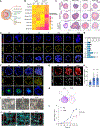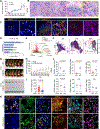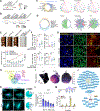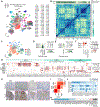Key Genetic Determinants Driving Esophageal Squamous Cell Carcinoma Initiation and Immune Evasion
- PMID: 37257519
- PMCID: PMC10527250
- DOI: 10.1053/j.gastro.2023.05.030
Key Genetic Determinants Driving Esophageal Squamous Cell Carcinoma Initiation and Immune Evasion
Abstract
Background & aims: Despite recent progress in identifying aberrant genetic and epigenetic alterations in esophageal squamous cell carcinoma (ESCC), the mechanism of ESCC initiation remains unknown.
Methods: Using CRISPR/Cas 9-based genetic ablation, we targeted 9 genes (TP53, CDKN2A, NOTCH1, NOTCH3, KMT2D, KMT2C, FAT1, FAT4, and AJUBA) in murine esophageal organoids. Transcriptomic phenotypes of organoids and chemokine released by organoids were analyzed by single-cell RNA sequencing. Tumorigenicity and immune evasion of organoids were monitored by allograft transplantation. Human ESCC single-cell RNA sequencing data sets were analyzed to classify patients and find subsets relevant to organoid models and immune evasion.
Results: We established 32 genetically engineered esophageal organoids and identified key genetic determinants that drive ESCC initiation. A single-cell transcriptomic analysis uncovered that Trp53, Cdkn2a, and Notch1 (PCN) triple-knockout induces neoplastic features of ESCC by generating cell lineage heterogeneity and high cell plasticity. PCN knockout also generates an immunosuppressive niche enriched with exhausted T cells and M2 macrophages via the CCL2-CCR2 axis. Mechanistically, CDKN2A inactivation transactivates CCL2 via nuclear factor-κB. Moreover, comparative single-cell transcriptomic analyses stratified patients with ESCC and identified a specific subtype recapitulating the PCN-type ESCC signatures, including the high expression of CCL2 and CD274/PD-L1.
Conclusions: Our study unveils that loss of TP53, CDKN2A, and NOTCH1 induces esophageal neoplasia and immune evasion for ESCC initiation and proposes the CCL2 blockade as a viable option for targeting PCN-type ESCC.
Keywords: CCL2; CDKN2A; Esophageal Squamous Cell Cancer; Immune Evasion; Immunotherapy; NOTCH; Organoids; Patient Stratification; Single-Cell RNA-Sequencing; TP53.
Copyright © 2023 AGA Institute. Published by Elsevier Inc. All rights reserved.
Conflict of interest statement
Disclosure of potential conflicts of interest
No potential conflicts of interest were disclosed.
Figures






References
-
- Pennathur A, Gibson MK, Jobe BA, et al. Oesophageal carcinoma. The Lancet 2013;381:400–412. - PubMed
-
- Board PATE. Esophageal Cancer Treatment (Adult) (PDQ(R)): Patient Version. PDQ Cancer Information Summaries. Bethesda (mD), 2002.
-
- Bejarano L, Jordao MJC, Joyce JA. Therapeutic Targeting of the Tumor Microenvironment. Cancer Discov 2021; 11:933–959. - PubMed
Publication types
MeSH terms
Substances
Grants and funding
LinkOut - more resources
Full Text Sources
Medical
Molecular Biology Databases
Research Materials
Miscellaneous

